The Clarkdale Review: Intel's Core i5 661, i3 540 & i3 530
by Anand Lal Shimpi on January 4, 2010 12:00 AM EST- Posted in
- CPUs
Ridiculously Fun to Overclock
We’ll start off with the obligatory maximum stock VID overclock of a 661 ES Clarkdale using Intel’s retail cooler:
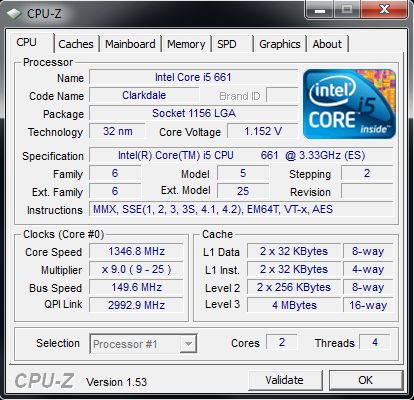
Maximum overclock @ stock voltages (3874MHz)
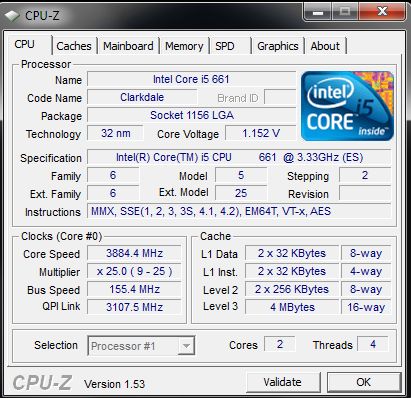
Maximum overclock @ stock voltages without Turbo
With increased core VID, speeds up to 4.3GHz are possible on the stock cooler:
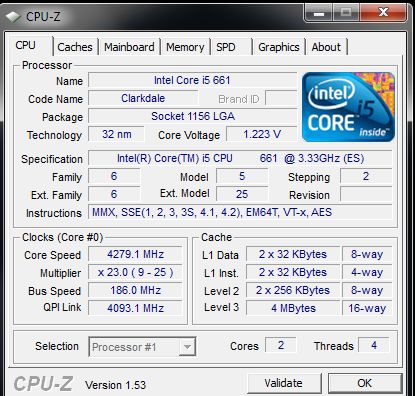
A 0.1V boost puts you in the 4.3GHz ballpark.
Watercooling
Clock for clock performance of Clarkdale against other platforms may not be impressive, but frequency scaling with good cooling is:
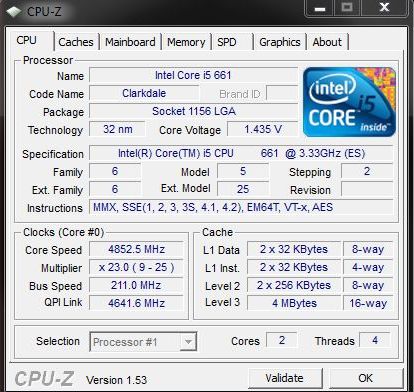
4853 MHz stable comes in with a processor load voltage of around 1.438V. Memory performance is related directly to the QPI link ratio. For best performance, keep the QPI link speed as close as possible to CPU core speed to minimize buffer hold times for lower memory access latency.
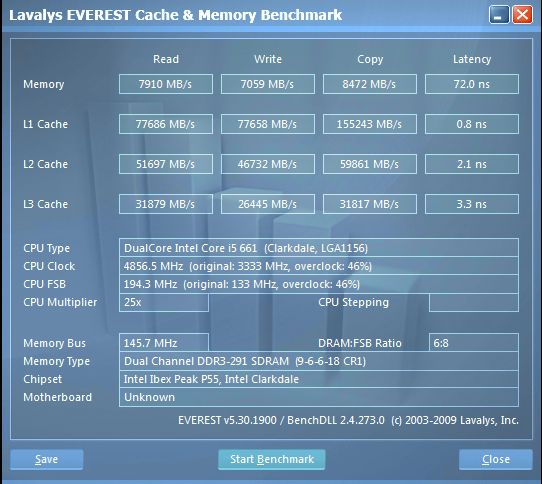
12X QPI Multiplier
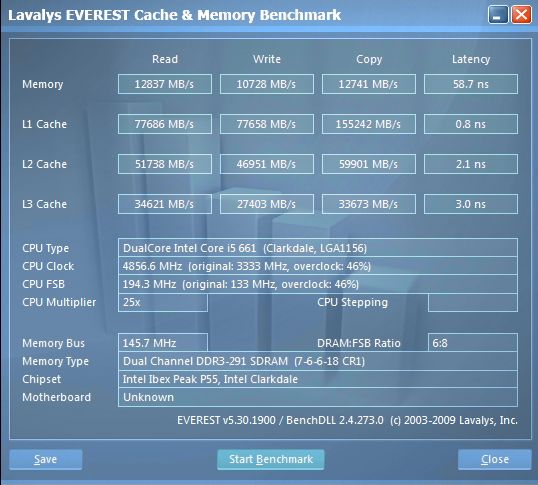
24X QPI Multi
The bandwidth figures are not stellar on either side of the scale (bear in mind the Everest bench DLL needs an update for Clarkdale). However, the higher QPI multiplier ratio is essentially free for the taking; requiring no additional IMC (VTT) voltage increase until BCLK is increased past 210 or so.
Like Lynnfield and Bloomfield, odd CPU multiplier ratios are more stable than even, although the disparity is less pronounced on Clarkdale. We found that even multipliers needed higher VCore at the same overall processor frequency or needed to be run at a lower overall overclock for stability. We’re not sure on the exact cause of this issue but it’s likely to be related to frequency synthesis within the CPU and downstream logic sampling.
Another caveat with Clarkdale overclocking is that the platform seems to be limited to memory speeds below 1600MHz as soon as you increase BCLK significantly (speeds over 1600Mhz are possible at stock BCLK). We’d hedge bets this is due to the memory controller relying on a preset DRAM clock skew table like Intel’s Front Side Bus architectures of old. The current DRAM frequency ceiling means that you’ll be shooting for CAS 5/6 capable memory between 1300-1600MHz for best performance with 4GB of RAM. 8GB configurations require a loose set of sub-timings, and also a 2N Command Rate to achieve 1600 MHz stable on our sample processor.
Sub-Zero
Bloomfield was hit and miss when it came to frequency scaling at low temperatures. Clarkdale seems to be a different animal altogether:

This is what ‘Clarkie’ is good at..
This screenshot was taken with our cascade cooling the CPU. Evaporator head temperatures were in the region of -115 Celsius. Most Lynnfield/Bloomfield CPUs were out of their comfort zone at these temperatures, but Clarkdale seems to be at home. You still get the occasional cold boot bug, but most of the ES CPUs will run benchmarks right down to the boiling point of LN2 (motherboard permitting). We’ve seen screenshots of 3D benchmarking above 6.5GHz and Super Pi runs edging close to 7GHz. Sounds great, but unfortunately, Super Pi 1M is the only benchmark where Clarkdale is really competitive. Once you’re past 230 BCLK, you have to leave QPI frequency on the floor which hurts memory performance in a big way. Couple that with the 1600MHz or so cap on DRAM frequency and you’ll understand why Super Pi 32m doesn’t fare so well on this platform. 3D performance in Futuremark’s 3DMark05 is just about competitive with the current ‘top’ Bloomfield results if you can run Clarkdale at 6.5GHz throughout the bench. The upshot is that we think there will be more good Clarkdale chips capable of 6.5GHz than there are Bloomfield CPUs that can run 3D benchmarks at 5.4GHz. The funny thing is that P55 motherboards using an NF200 to provide triple CrossFire/SLI might actually be the way to go for benchmarks like 3D Mark 05 if you’re into competitive benchmarking!
While Clarkdale may not be the fastest performer from Intel, it’s probably the most fun to overclock.










93 Comments
View All Comments
rainman1986 - Monday, January 4, 2010 - link
I'm puzzled by the results for this cpu, I'd have thought it would be close to the 920, but it was much slower than the i3 and i5.Did I miss something?
rainman1986 - Monday, January 4, 2010 - link
Sorry, not the 860, the 870 was slower (but the 860 would have been just a little slower than that!)Still, what gives?
deruberhanyok - Monday, January 4, 2010 - link
Possible responses:"I had no idea it had a retro mode!"
"So these processors can run Ultima IX acceptably then?"
"My eyes! The goggles, they do nothing!"
"Intel HD graphics: bringing extreme video quality to 2001's hottest titles!"
And so on.
vol7ron - Monday, January 4, 2010 - link
The Clarkdale Unencrypted score is shown, could you also display the Lynnfield Unencrypted score.To use the unencrypted Clarkdale as the control for Lynnfield doesn't seem right since there are differences between the two procs. It would make more sense to compare
[Lynnfield Encrypted Score]/[Lynnfield Unencrypted Score] to [Clarkdale Encrypted Score]/[Clarkdale Unencrypted Score]
Thanks,
vol7ron
SydneyBlue120d - Monday, January 4, 2010 - link
Thanks a lot for the great review!When You'll be back from CES, I'd like to see a test of:
- Pentium G9650 (the great absent for the corporate/office world);
- Flash 10.1 and BR/MKV HTCP with integrated gfx;
Thanks a lot :-)
SydneyBlue120d - Monday, January 4, 2010 - link
Forgot to ask:Is the integrated gfx DX 10 or 10.1? Will it support Direct2D?
Thanks
ruetheday - Friday, January 8, 2010 - link
yes to DX10 and Direct2Dvol7ron - Monday, January 4, 2010 - link
Raja,Good article. I like how you re-addressed topics that you originally discussed on the opening page, with a more concise statement on the pages that followed. For instance, when talking about the memory on/off die. You gave a decent bit of info on page 1 and then a quick rememberance on page 2.
--- More will come once I finish reading the artice :) ---
vol7ron
Rajinder Gill - Monday, January 4, 2010 - link
Credit goes to Anand for this piece. I only chimed in on the OC side. :)regards
Raja
vol7ron - Monday, January 4, 2010 - link
I noticed something fishy when it said thanks to Raja for the Mobo suggestion. I guess the article's author threw me off :)Great collaboration, regardless.